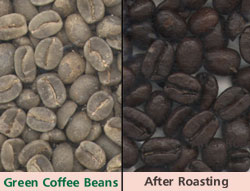
 |
Turkish Coffee Page |
A taste of home
"Ei, wie
schmeckt der Coffee süße, lieblicher als tausend Küsse"
"Ah, how sweet coffee tastes! Lovelier than a thousand
kisses" (Johann Sebastian Bach, "Kaffeekantate",1732)
| There are many ways of brewing coffee, but there's
one enjoyed for more than thousand years: the Turkish
coffee. This kind of coffee brew was discovered by the
Arabs, venturing into Africa, the homeland of coffee.
They started their own coffee plantations, and soon
established the whole ritual around coffee brewing and
serving. When Turks converted to Islam, they also took
the habit of enjoying coffee. Since then, the name of
Turkish coffee remains, even though this coffee is not
drunk only in Turkey but all over the globe. In Bosnia-Herzegovina, we mostly drink Turkish coffee. Even when I'm far from home, I use to carry the coffee mixture, pot and cups for Turkish coffee. I simply can't be without it. Taste it once, and you'll be convinced! |
 |
 |
What is Turkish coffee? Turkish coffee is the original way of coffee brew. It is made as follows: water is boiled in a boiling-pot, coffee is put in a special Turkish coffee-pot (called dzezva or ibrik), then the boiling water is poured into dzezva, and finally the coffee is briefly put on fire again. The result: full-taste coffee beverage, covered with coffee foam on the top and incredible taste inside! Some Western coffee-drinkers, used to espresso or filtered coffee, may find it strong at first taste, but it is worth it. The most important thing is that Turkish coffee is not for people in hurry. It has to be tasted slowly, enjoying every sip of it. |
The competition
| Turkish coffee was the only type of coffee making
until 1901, when instant coffee was discovered. In 1903,
the decaffeinated coffee (I think of it as a
contradiction) comes to the market. In 1933, Italian
coffee comes forward: the famous espresso. And
finally, cappuccino comes in 1946. I don't mind espresso,
because it doesn't kill the taste of the coffee beans,
although the beans are separated. But, the original is
the original! In Bosnia, you can have espresso in every bar, but if you want to try the authentic taste of the country, go into nearest traditional restaurant and ask for freshly brewed Turkish coffee. |
|
The ritual
|
Brewing the coffee is just the first part of enjoying
Turkish coffee. The drinking is another one, not less
important! Coffee drinking must be understood as a small
break in time, the moment to enjoy the life and forget
all other things. Coffee is always served in dzezva and small coffee cups without handle, called fildzan. The tradition foresees no sugar, but if you like sweet coffee, you can use sugar in lumps. Never use normal, grain sugar! One lump will do for one cup of coffee. Also, Turkish coffee is often accompanied by the Turkish sweet jelly, or rahat-lokum, or datils. Remember, never drink your Turkish coffee in a hurry! You would waste the most important thing: the joy of coffee taste. |
| Serving
Turkish coffee This coffee is served as follows: first of all, any sugar is added into fildzans. Then, coffee foam on the top of the pot is taken and poured into fildzans with a small spoon. Only then coffee can be poured. The traditional Turkish coffee is black and strong, with just a bit of sugar. Also, the coffee must be stirred prior to serving. It is a tradition to first serve the guest. Note: if ever invited to take coffee by a Bosnian family, never say no! It is considered a grave fault. If possible, accept; if not, try to come again as soon as possible. |
 |
Tips and tricks
| Never use coffee bought in the shop, unless it is
expressly stated as for Turkish coffee. The "normal"
coffee is milled somewhat roughly, and Turkish coffee
mixture is milled in fine grain, which allows water to
take all the taste from inside the coffee bean. If you
have time, consider buying green coffee beans and
roasting them in house. The taste is much better with
freshly toasted coffee. And, finally, never let coffee to
be stored more than a week. Its taste gradually
evaporates. Try to use hand-mills for coffee, it adds more "handcraft" feeling for your daily cup of coffee. If your coffee is boiling when put on fire, you have added too much water. Throw away and make coffee again! |
|
Copyright 2001 Edin Kapic